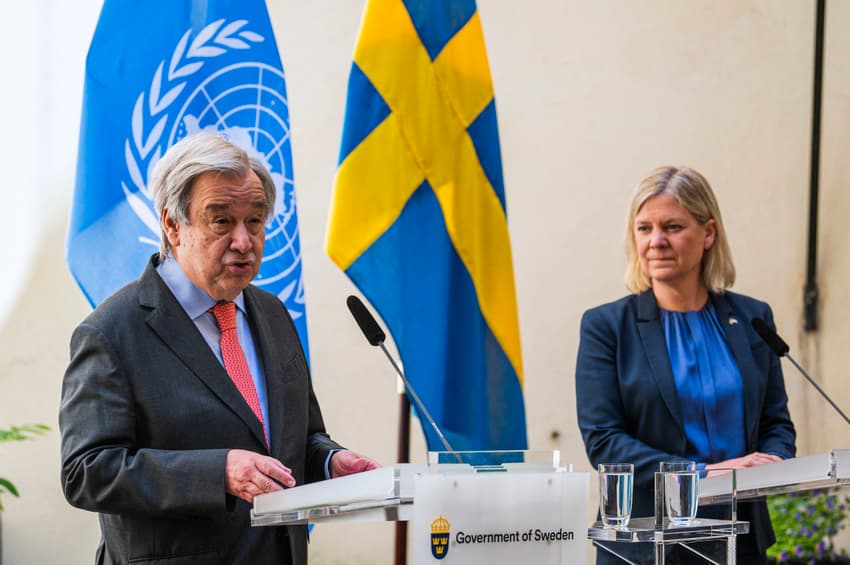'The war must end now': UN Sec-Gen meets Swedish PM in Stockholm

UN Secretary General Antonio Guterres met Sweden's Prime Minister in Stockholm on Wednesday, ahead of the conference marking the 50th anniversary of the city's historic environment summit .
After a bilateral meeting with Magdalena Andersson on the security situation in Europe, Guterres warned that Russia's invasion of Ukraine could lead to a global food crisis that would hurt some of the world's most vulnerable people.
"It is causing immense suffering, destruction and devastation of the country. But it also inflames a three-dimensional global crisis in food, energy and finance that is pummelling the most vulnerable people, countries and economies," the Portuguese diplomat told a joint press conference with Andersson.
He stressed the need for "quick and decisive action to ensure a steady flow of food and energy," including "lifting export restrictions, allocating surpluses and reserves to vulnerable populations and addressing food price increases to calm market volatility."
Between the two, Russia and Ukraine produce around 30 percent of the global wheat supply.
Guterres was in Stockholm to take part in the Stockholm 50+ conference, which celebrates the 50th anniversary of the United Nations Conference on the Human Environment.
The conference, which was held on the suggestion of the Swedish government in 1972 was the first UN meeting to discuss human impacts on the global environment, and led to the establishment of the UN Environment Program (UNEP).
At the joint press conference, Andersson said that discussions continued between Sweden and Turkey over the country's continuing opposition to Sweden's application to join the Nato security alliance.
"We have held discussions with Turkey and I'm looking forward to continuing the constructive meetings with Turkey in the near future," she said, while refusing to go into detail on Turkey's demands.
"We are going to take the demands which have been made of Sweden directly with them, and the same goes for any misunderstandings which have arisen," she said.
At the press conference, Guterres condemned the Russian invasion of Ukraine as "a violation of its territorial integrity and a violation of the UN Charter".
"The war must end now," he said.
Comments
See Also
After a bilateral meeting with Magdalena Andersson on the security situation in Europe, Guterres warned that Russia's invasion of Ukraine could lead to a global food crisis that would hurt some of the world's most vulnerable people.
"It is causing immense suffering, destruction and devastation of the country. But it also inflames a three-dimensional global crisis in food, energy and finance that is pummelling the most vulnerable people, countries and economies," the Portuguese diplomat told a joint press conference with Andersson.
He stressed the need for "quick and decisive action to ensure a steady flow of food and energy," including "lifting export restrictions, allocating surpluses and reserves to vulnerable populations and addressing food price increases to calm market volatility."
Between the two, Russia and Ukraine produce around 30 percent of the global wheat supply.
Guterres was in Stockholm to take part in the Stockholm 50+ conference, which celebrates the 50th anniversary of the United Nations Conference on the Human Environment.
The conference, which was held on the suggestion of the Swedish government in 1972 was the first UN meeting to discuss human impacts on the global environment, and led to the establishment of the UN Environment Program (UNEP).
At the joint press conference, Andersson said that discussions continued between Sweden and Turkey over the country's continuing opposition to Sweden's application to join the Nato security alliance.
"We have held discussions with Turkey and I'm looking forward to continuing the constructive meetings with Turkey in the near future," she said, while refusing to go into detail on Turkey's demands.
"We are going to take the demands which have been made of Sweden directly with them, and the same goes for any misunderstandings which have arisen," she said.
At the press conference, Guterres condemned the Russian invasion of Ukraine as "a violation of its territorial integrity and a violation of the UN Charter".
"The war must end now," he said.
Join the conversation in our comments section below. Share your own views and experience and if you have a question or suggestion for our journalists then email us at [email protected].
Please keep comments civil, constructive and on topic – and make sure to read our terms of use before getting involved.
Please log in here to leave a comment.